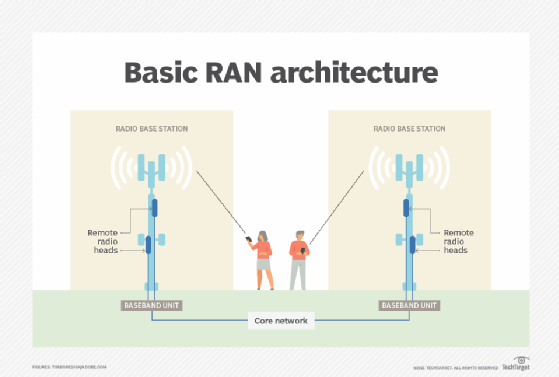What is Open RAN (ORAN)? Benefits and use cases
Open RAN, or ORAN, is a type of mobile network architecture where the radio access network -- the system that connects an end user's device to other parts of the network -- is built from non-proprietary components.
The radio access network, or RAN, is the radio element of a cellular network that links user equipment, such as cellphones, computers or other devices, to the core network.
RANs are typically composed of transport networks, antennas, radio units and baseband units. These elements connect to the core network over fiber or wireless backhaul links. Open RAN ensures these components use open and standardized equipment, providing network operators with greater flexibility and interoperability in vendor network equipment.
How does Open RAN work?
RAN architecture is structured differently depending on the implementation of wireless technology and the type of network. Open RAN architecture, for example, typically consists of the following:
- Radio units (RU). Radio technology transmits and receives digital data as radio signals.
- Antennas. These help transmit electrical signals to radio waves.
- Distributed Unit. The DU handles lower layers of processing and the protocol stack, such as the media access control address and radio link control layer.
- Centralized Unit. The CU handles higher layers of processing and the protocol stack, particularly security and the radio resource control layer.
- The transport network. This includes the fronthaul, midhaul and backhaul data links that connect the RAN to the core network.
In traditional settings, this architecture is typically provided by a single vendor along with proprietary software offerings. Open RAN, however, works by splitting the RAN into modular parts run by different software and interfaces. The baseband units (BBUs) and remote radio heads (RRHs) of traditional RAN architectures are disaggregated and split into the RU, DU and CU, with open interfaces set between them. These functions can also be virtualized and containerized, and can come from different vendors.
This separation enables the RAN to be more flexible, accommodating the network functions virtualization techniques, such as network slicing and high multiple input, multiple output (MIMO) that are necessary for 5G.
ORAN standardization efforts are typically set by the O-RAN Alliance, which helps ensure different vendor technologies can work together.
Open RAN vs virtual RAN vs traditional RAN
Traditional RAN consists of antennas, the RRH, the BBU and the transport network. BBUs provide a set of signal processing functions that enable wireless communication. Traditional baseband uses custom electronics combined with multiple lines of code to enable wireless communication, typically using the licensed radio spectrum. BBU processing detects errors, secures the wireless signal and ensures that wireless resources are used effectively. Additionally, the RRH is responsible for converting digital signals from the baseband unit into analog radio signals and vice versa. Due to the use of proprietary vendor technology, however, traditional RAN is tightly integrated and typically does not allow for the configuration of different equipment or software.

Virtual RAN (vRAN) has transformed the traditional RAN architecture by splitting and centralizing control of wireless functions to optimize performance and reduce costs. The main components of vRAN include the RU, DU, CU and transport networks. vRAN deployments, however, are still sometimes proprietary and remain controlled by a single vendor.
ORAN, comparatively, introduces open and standardized interfaces. BBU and RRH are also disaggregated in ORAN -- being split into the RU, DU and CU. These elements can be sourced from various vendors. This avoids vendor lock-in and provides increased network flexibility.
How Open RAN helps organizations use multi-vendor networks
The open interfaces provided by ORAN help enable vendor interoperability. Instead of a single vendor controlling all the components in the RAN, as in traditional architectures, ORAN enables network operators to choose what hardware and software they want to use from each available vendor.
The O-RAN Alliance creates voluntary standards for vendor technologies to meet. So, organizations can mix and match either the best-performing or most cost-effective technologies available for each component.
Multi-vendor environments are managed and stitched together using a RAN Intelligent Controller (RIC) and other orchestration tools. The RIC, specifically, enables network operators to control and optimize RAN functions from different vendors.
Future of Open RAN technology
It is likely that ORAN technologies will continue to see increased adoption in the future, as large carriers such as Verizon and AT&T currently use or plan to implement them.
ORAN might also come to play a larger role in 5G communications, as most early 5G networks deployed were RAN networks that use a 4G core network to handle data sessions. Standalone 5G is also becoming more common. By enabling network operators to choose different hardware and software components, the implementation of 5G networks becomes more cost-efficient.
AI and machine learning optimizations in RICs might also experience continued adoption and increased use. Some AI-enabled features can include automated fault detection, radio frequency optimization, real time processing and other network automation features.
AI and machine learning have many different potential use cases in ORAN networks. Learn how they can be used to alleviate network complexities.





